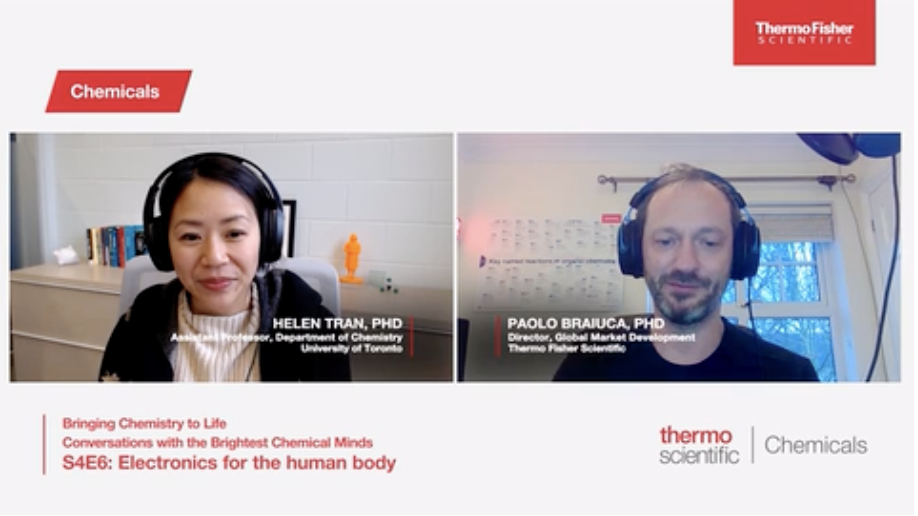Audio is capturing the ears of consumers. Consumers spent 15 billion hours listening to podcasts in 2022, up 25% from 2020. It’s no surprise that marketers are taking notice. Done well, audio storytelling presents new opportunities for brands to connect to their audiences and adds a new lens through which to view scientific work.
What Makes A Good Audio Story?
Whether producing 30-minute podcasts or two-minute audio clips, a marketer is only as good as the story they’re telling—and creating good audio stories requires a different toolkit than written communication. We talked to science podcasters and audio experts to understand what makes a great audio story.
1. Lean into the personal connection
Audio stories let brands emotionally connect with audiences. Hearing the emotion in someone’s voice reaches audiences on a different level than the same words in text alone.
“Science itself isn’t always emotional, but every person doing science has, if nothing else, the emotions of discovery and adventure.” says science podcaster Chris Conner. “That’s what I’m looking for when producing an audio story. Can we take someone on a journey and make them feel something?”
Tapping into the emotional connection makes the story more memorable for the listener and adds an important human perspective often lost in technical scientific writing.

“A common way to tell science stories is through research papers, which, if not developed correctly, can end up dry and uninspiring for the reader,” says Paolo Braiuca, Director of Global Market Development at Thermo Fisher Scientific. “The people doing the science are just a list of names on a piece of paper—we lose the impact of learning any personal elements about our colleagues or the scientific community that we’re a part of.”
“Modern science is about collaboration,” Braiuca says, so the human connection fostered by audio is critical to the field. On his podcast, Bringing Chemistry to Life from Thermo Scientific Chemicals, scientists can extend their message beyond their immediate network of collaborators so physicists can learn from chemists, for example.
2. Understand your audience
Ultimately, audio is a tool just like any other. “The magic is in the wizard, not in the wands,” says Braiuca. “If you don’t understand your customers, you have no chance of speaking effectively to them.”
Audio is an amazing lever to get your customers’ attention, but in order to capitalize on that opportunity, you still must ensure your tone and narrative are consistent with your audience’s needs—meaning no business jargon or direct marketing.
We never speak about products, and we never try to position things, yet the podcast is one of the most successful marketing campaigns we run in terms of engagement.”
– Paolo Braiuca of Thermo Fisher Scientific
Audio programming like podcasts can help develop positive brand sentiment by showing your company’s perspective and how it aligns with your customers, even if it’s as simple as your company cares about innovative science and the people who are doing it.
One way to tap into your audience is to look at what’s working in your existing campaigns and use audio to amplify a message you already know is resonating. Thermo Fisher Scientific used this strategy to launch Bringing Chemistry to Life as a Talented 12 podcast, highlighting the work of up-and-coming chemists. The audio series was inspired by Thermo Fisher’s long-term partnership with C&EN and sponsorship of the Talented 12 campaign — the audio extension built on work the team was already doing to extend its reach without starting a new program from scratch.
3. Go long
While audio stories can be any length, experts we talked to spoke about the particular advantage of using audio to tell longer-form stories.
“Audio lets you go a bit deeper,” says Braiuca. “You’re not going to write a 75-page article to say the same thing. The transcripts of our audio are incredibly long—no one is going to read that in raw form—yet tens of thousands of people will listen to us for a half hour. And there are ways to use the raw transcript to develop more accessible articles as downstream content as well.”
The screenless consumption of audio also is well-suited for longer-form stories. “Audio can be as engaging as video. Most people won’t watch a 30-minute video, but they’ll listen to a 30-minute audio story as they’re at the gym, mowing their lawn, or multi-tasking in other ways,” says Conner.
4. Quality matters, but don’t overthink it.
“The sound quality is hugely important, or people just won’t listen, no matter how good the story is,” says Conner. Luckily, “it doesn’t take a lot to get good gear.” He records on Riverside.fm, which captures both audio tracks separately for easy tuning, then uses Descript to edit.
While audio quality is important, Braiuca also cautions that marketers getting started on audio tend to spend too much time thinking about microphones and not enough thinking about their story. “People are too worried about their technical setup and not worried enough about the format,” says Braiuca.
Understanding what you want to say, both at a macro strategy level and for each audio story, is critical to producing podcasts that build audiences.
Getting Started With Audio Storytelling
Telling compelling stories via audio lets you spend more time with your audience because many listeners consume them passively, whether on walks, commutes, or while at home cooking dinner. In many instances, this allows you to be present in your customer’s life beyond the working day.
For marketers, being top-of-mind for your customers when they’re away from the office—or lab—is an unparalleled opportunity earned by compelling narratives they can’t get in other forms.
Here are some tips to get started with audio:
If you’re looking for a partner to help create audio stories, talk to the experts at C&EN BrandLab. We’ll show you how audio stories can help drive brand and solution awareness and deeper audience engagement. Contact us for a consultation today.


















